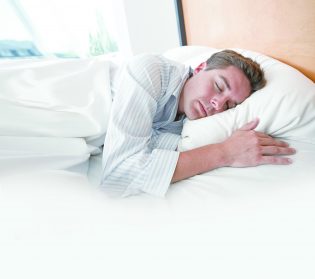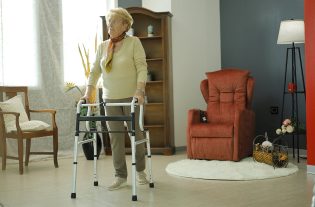Sleep apnoea is a medical condition characterised by cyclic pauses in breathing while sleeping.
This occurs because the airways are repeatedly blocked, by either a total or partial obstruction, due to collapse of the tissues at the back of the throat.
These temporary pauses in breathing deprive the brain and the entire body of oxygen and lead to reawakening.
 It can occur several times during the night and result in poor sleep.
It can occur several times during the night and result in poor sleep.
The chronic lack of sleep caused by sleep apnoea can result in tiredness during the day, slow reflexes, poor concentration and an increase in the risk of accidents.
Sleep apnoea can also lead to sudden changes in mood, irritability and even depression.
This condition can affect children, adults and people of both genders, although it is more common in men.
Sleep apnoea is extremely common and has a potential impact on health, so it is essential to understand what it is and how to manage it.
What is sleep apnoea?
It is a disorder that causes pauses in breathing and is classified according to three incremental levels: apnoea, when the pause in breathing lasts from ten seconds to under three minutes; hypopnoea, when there is a partial reduction in breathing; RERA (Respiratory Effort Related Arousal), when there is a limitation in breathing that results in increased respiratory effort and culminates in an arousal.
Lastly, there is obstructive sleep apnoea syndrome, in which the number of episodes of apnoea is equal to or higher than five per hour, or when there is a number of events at least equal to or high than fifteen, accompanied by clear respiratory efforts.
Diagnosis
The diagnosis is based, first and foremost, on the symptoms reported by the patient or their partner.
A physician who suspects the disorder is present might carry out instrumental tests on the various parameters, such as a polysomnography, a respiratory polygraphy, an electrocardiogram or an electromyography of the limbs.
Treatment
Patients who suffer from sleep apnoea are advised to sleep on their side, to lose weight if they are obese or overweight and to avoid alcohol and sleeping pills.
Pharmacological treatments, on the other hand, involve surgery for correction of a deviated septum or hypertrophic tonsils and use of positive pressure ventilators.
Positive pressure ventilators
 Non-invasive positive pressure ventilators, commonly known as CPAP-APAP, apply continuous positive airway pressure, through an external mask, during all phases of breathing (rest, inhalation, exhalation). They are indicated for sleep apnoea (OSAS), for treatment of various sleep disorders and in treatment of COVID patients.
Non-invasive positive pressure ventilators, commonly known as CPAP-APAP, apply continuous positive airway pressure, through an external mask, during all phases of breathing (rest, inhalation, exhalation). They are indicated for sleep apnoea (OSAS), for treatment of various sleep disorders and in treatment of COVID patients.
The traditional CPAP models have an air flow at constant pressure, whereas the Auto-Cpap are able automatically to alter the level of pressure supplied, within a range established by the specialist, in response to the change in flow (apnoea/hypopnoea or restriction) and/or the intensity of snoring.
They are normally used by patients who are unable to adapt to treatment with CPAP or by OSAS patients with apnoea/hypopnoea that occurs in certain phases of sleep.
The features of the most evolved CPAP machines include the presence of a humidifier, which makes the treatment more comfortable, and a microSD on which to record the treatment data during use, to make it accessible to the physician.
The Kyara range of breathing treatment solutions of Moretti SpA
The positive pressure ventilation machines in the Kyara range of Moretti SpA include both functions that can be directly consulted by patients and functions that are programmable by the physician.
 Patients can immediately consult the AHI value, which indicates the number of episodes of apnoea and hypopnoea per hour, the total number of hours of operation of the device in the last session and the number of hours of treatment received during that session.
Patients can immediately consult the AHI value, which indicates the number of episodes of apnoea and hypopnoea per hour, the total number of hours of operation of the device in the last session and the number of hours of treatment received during that session.
The ventilators also record the average pressure of the last treatment (cmH2O/hPa), the average loss of air per minute of the last treatment (L/min) and the P90, meaning the pressure for 90% of the last treatment (cmH2O/hPa).
The physician can set the units of pressure (cmH2O or hP) and all the pressure values of the two different operating methods.
The physician can also set: the FPS (Flow Pressure Synchronism) level, in order to assist breathing and thus reduce the pressure by 1 cmH2O when the device detects exhalation by the patient; the rise time, designed to make the start of treatment more comfortable and adjustable from 0 to 45 minutes, with 5-minute increments; and the humidifier.
The humidifier is designed to humidify the air and to make the treatment more comfortable, by eliminating the problem of dryness of the airway.
What precautions should be taken in use of positive pressure ventilators?
Positive pressure ventilators are a useful support for the treatment of sleep apnoea or for treatment of patients recovering from COVID.
They can be used easily in both a hospital and in the home, when they have been prescribed and programmed by a physician.
It should be remembered that they are devices intended for patients who are able to breath independently and that the presence of a humidifier makes the treatment much more tolerable.










